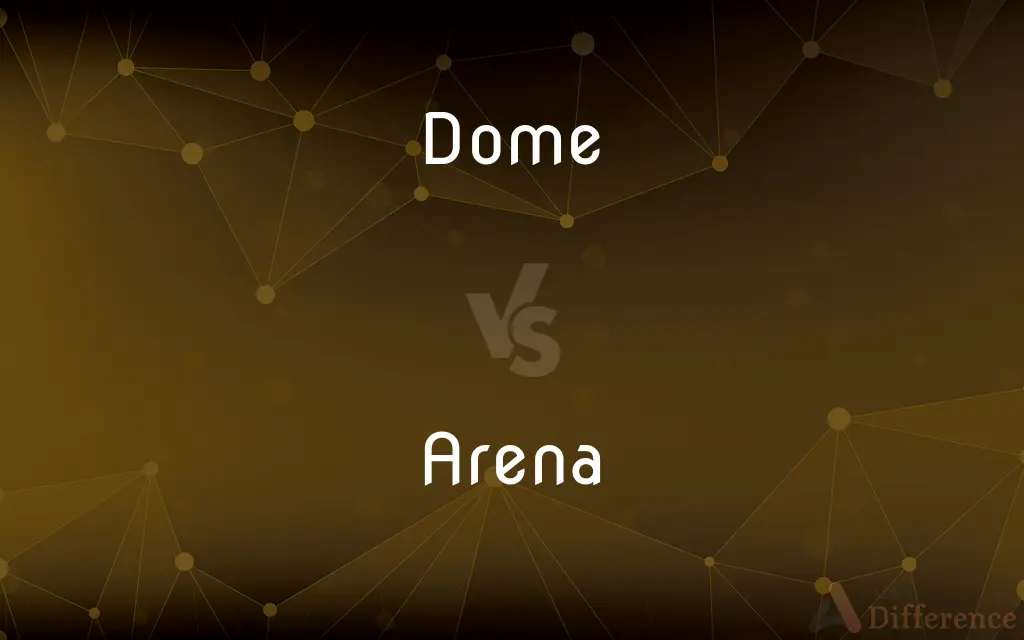Dome vs. Arena — What's the Difference?
By Fiza Rafique & Maham Liaqat — Updated on March 28, 2024
A dome is a rounded vault forming the roof of a building or structure, while an arena is a large, enclosed area used for sports and entertainment.

Difference Between Dome and Arena
Table of Contents
ADVERTISEMENT
Key Differences
Domes serve as architectural marvels with their rounded vaults, primarily used for roofs or ceilings, emphasizing aesthetics and acoustics. Whereas arenas are vast, enclosed spaces designed to host large-scale events like sports, concerts, and public gatherings, focusing on capacity and functionality.
The construction of a dome involves complex geometric and engineering principles to create its iconic curved shape, enhancing the building's visual and acoustic properties. On the other hand, arenas are constructed with a focus on maximizing space and accommodating thousands, often featuring versatile seating arrangements and state-of-the-art facilities.
Domes are often associated with religious and historical buildings, symbolizing the heavens or the sky, and are admired for their beauty and engineering. Meanwhile, arenas are central to modern entertainment and sports, serving as hubs for major events and fostering a sense of community and excitement.
The interior of a dome can create unique acoustic effects, making them ideal for concerts and ceremonies, while arenas are equipped with advanced sound systems to manage acoustics in a large, open space, ensuring clear sound quality for all attendees.
Comparison Chart
Primary Use
Architectural feature for roofs or ceilings
Venue for sports, concerts, and large public events
ADVERTISEMENT
Construction
Complex geometry for curved shape
Designed for maximum capacity and versatility
Associated With
Religious and historical buildings
Modern entertainment and sports
Focus
Aesthetics and acoustics
Capacity and functionality
Acoustics
Natural acoustics ideal for music and ceremonies
Advanced sound systems for clear sound in open spaces
Compare with Definitions
Dome
A rounded vault forming the roof of a building or structure.
The dome of the cathedral is visible from miles away.
Arena
A hub for community and major events.
The arena hosts everything from basketball games to graduation ceremonies.
Dome
An element of architecture that represents the heavens or sky.
The museum's dome features a painted sky filled with stars.
Arena
Designed for versatility and large capacity.
The arena’s seating arrangement changes based on the event.
Dome
A symbol of architectural innovation and beauty.
The dome was constructed using revolutionary engineering techniques.
Arena
Features state-of-the-art facilities and systems.
The arena is equipped with advanced lighting and sound systems.
Dome
A structure that provides an acoustic advantage for sounds.
The dome’s design enhances the choir’s performance.
Arena
Focused on providing clear sightlines and acoustics.
Every seat in the arena offers a clear view of the stage.
Dome
Used in both ancient and modern constructions.
Modern stadiums incorporate domes for aesthetic and practical reasons.
Arena
A large, enclosed area for sports and entertainment.
The arena can seat over 20,000 fans for concerts.
Dome
A dome (from Latin: domus) is an architectural element similar to the hollow upper half of a sphere; there is significant overlap with the term cupola, which may also refer to a dome or a structure on top of a dome. The precise definition of a dome has been a matter of controversy and there are a wide variety of forms and specialized terms to describe them.
Arena
An arena is a large enclosed platform, often circular or oval-shaped, designed to showcase theatre, musical performances, or sporting events. It is composed of a large open space surrounded on most or all sides by tiered seating for spectators, and may be covered by a roof.
Dome
A roof or vault having a circular, polygonal, or elliptical base and a generally hemispherical or semispherical shape.
Arena
An enclosed area for the presentation of sports events and spectacles.
Dome
A geodesic dome.
Arena
A building housing such an area.
Dome
A domelike structure or object.
Arena
A place or scene where forces contend or events unfold
Withdrew from the political arena.
The world as an arena of moral conflict.
Dome
A system of strata that is uplifted in the center, forming a concentric anticline.
Arena
The area in the center of an ancient Roman amphitheater where contests and other spectacles were held.
Dome
A mass of granite that has been weathered into a rounded shape by exfoliation.
Arena
An enclosed area, often outdoor, for the presentation of sporting events (sports arena) or other spectacular events; earthen area, often oval, specifically for rodeos (North America) or circular area for bullfights (especially Hispanic America).
A large crowd filled the seats of the arena.
Dome
A mound formed by the extrusion of viscous lava from a volcano.
Arena
The building housing such an area; specifically, a very large, often round building, often topped with a dome, designated for indoor sporting or other major events, such as concerts.
The arena is grey with white beams.
Dome
(Chemistry) A form of crystal with two similarly inclined faces that meet at an edge parallel to the horizontal axis.
Arena
(historical) The sand-covered centre of an amphitheatre where contests were held in Ancient Rome.
The gladiators entered the arena.
Dome
(Slang) The human head.
Arena
A realm in which events take place; an area of interest, study, behaviour, etc.
The company was a player in the maritime insurance arena.
Dome
(Archaic) A large, stately building.
Arena
The area in the central part of an amphitheater, in which the gladiators fought and other shows were exhibited; - so called because it was covered with sand.
Dome
To cover with or as if with a dome.
Arena
Any place of public contest or exertion; any sphere of action; as, the arenaof debate; the arena of life.
Dome
To shape like a dome.
Arena
"Sand" or "gravel" in the kidneys.
Dome
To rise or swell into the shape of a dome.
Arena
A particular environment or walk of life;
His social sphere is limited
It was a closed area of employment
He's out of my orbit
Dome
(architecture) A structural element resembling the hollow upper half of a sphere.
Geodesic dome
Arena
The central area of an ancient Roman amphitheater where contests and spectacles were held; especially a sand-strewn area
Dome
(by extension) Anything shaped like an upset bowl, often used as a cover.
A cake dome
Lava dome
Arena
A large structure for open-air sports or entertainments
Dome
(informal) A person's head.
Arena
A playing field where sports events take place
Dome
A building; a house; an edifice.
Pleasure dome
Dome
(by extension) Any erection resembling the dome or cupola of a building, such as the upper part of a furnace, the vertical steam chamber on the top of a boiler, etc.
Steam dome
Dome
(crystallography) A prism formed by planes parallel to a lateral axis which meet above in a horizontal edge, like the roof of a house; also, one of the planes of such a form.
Dome
(geology) A geological feature consisting of symmetrical anticlines that intersect where each one reaches its apex.
Dome
(transitive) To give a domed shape to.
Dome
To shoot in the head.
That guy just got domed!
Dome
To perform fellatio on.
Dome
A building; a house; an edifice; - used chiefly in poetry.
Approach the dome, the social banquet share.
Dome
A cupola formed on a large scale.
Dome
Any erection resembling the dome or cupola of a building; as the upper part of a furnace, the vertical steam chamber on the top of a boiler, etc.
Dome
A prism formed by planes parallel to a lateral axis which meet above in a horizontal edge, like the roof of a house; also, one of the planes of such a form.
Dome
Decision; judgment; opinion; a court decision.
Dome
A concave shape whose distinguishing characteristic is that the concavity faces downward
Dome
Informal terms for a human head
Dome
A stadium that has a roof
Dome
A hemispherical roof
Common Curiosities
How do modern arenas accommodate large crowds?
They are designed with versatile seating, ample exits, and state-of-the-art facilities to safely accommodate thousands.
Are domes always part of religious buildings?
While commonly found in religious buildings, domes are also used in secular buildings for their aesthetic and structural benefits.
Can arenas be used for events other than sports?
Yes, arenas can host a wide range of events including concerts, conventions, and ceremonies.
What is the main architectural feature of a dome?
The main feature is its rounded vault, which forms the roof or ceiling of a building.
Why are domes considered symbols of architectural innovation?
Their complex design and construction techniques demonstrate advanced engineering and architectural skills.
How do the acoustics in a dome compare to those in an arena?
Domes naturally enhance acoustics due to their shape, whereas arenas rely on advanced sound systems.
Can a dome be part of an arena's design?
Yes, some arenas incorporate domes into their design for aesthetic appeal or to improve acoustics.
What is the primary purpose of a dome in architecture?
Its purpose is both aesthetic and functional, adding beauty to the building while enhancing its acoustics.
What makes a dome an architectural marvel?
Its combination of beauty, innovation, and the engineering required to construct its unique shape.
How do the construction techniques of domes and arenas differ?
Dome construction focuses on geometric complexity for the curved shape, while arenas focus on versatility and capacity.
How does the interior design of a dome affect its use?
The design can influence the building's acoustics, making it suitable for music and ceremonies.
Can the design of a dome influence its acoustics?
Yes, the shape of a dome can naturally enhance sound quality within the space.
What role do arenas play in modern society?
Arenas are central to entertainment and sports, serving as communal hubs for major events.
What technological advancements are commonly found in arenas?
Advanced lighting, sound systems, and versatile seating arrangements are standard.
How is the capacity of an arena determined?
Capacity is based on its design, focusing on maximizing space and ensuring safety for all attendees.
Share Your Discovery

Previous Comparison
Heritage vs. Origin
Next Comparison
Giant vs. GolemAuthor Spotlight
Written by
Fiza RafiqueFiza Rafique is a skilled content writer at AskDifference.com, where she meticulously refines and enhances written pieces. Drawing from her vast editorial expertise, Fiza ensures clarity, accuracy, and precision in every article. Passionate about language, she continually seeks to elevate the quality of content for readers worldwide.
Co-written by
Maham Liaqat













































